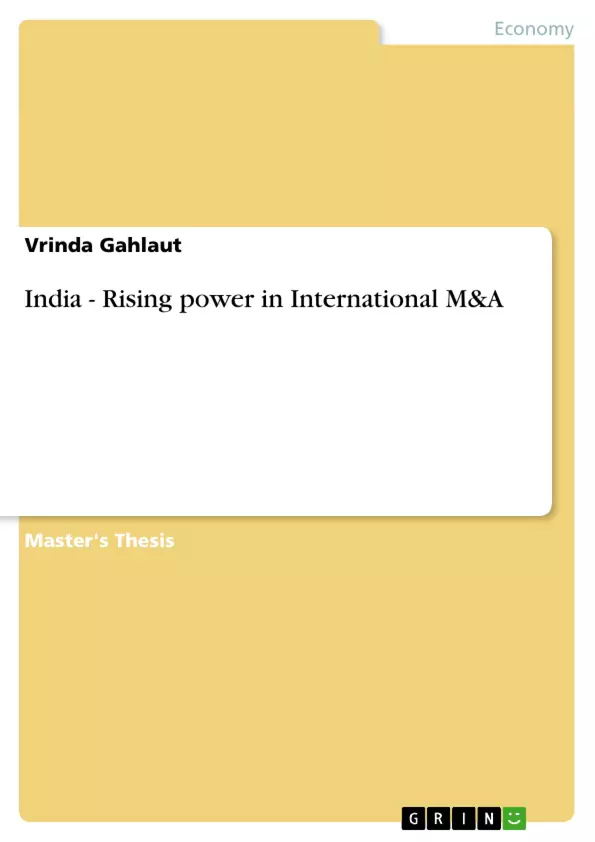Mergers and Acquisitions have long been part of global corporate history and have played a vital role in shaping the business landscape of each decade. With the passage of time, the sheer volume and size of M&A transactions have reached unprecedented levels. While some have welcomed this, a prominent section of observers is sceptical about the rationale behind such “megadeals”. This field has undergone tremendous transformation not only in terms of deal sizes and volumes but also in terms of the ‘deal makers’. Mergers and acquisitions which was until a few years back an almost exclusive domain of organisations from developed countries, ones that had the financial muscle and political leverage to pull-off such deals, has now reformed with new entrants like India, China, Brazil, Russia, Indonesia, South Korea, Mexico etc cutting important deals beyond geographical and political boundaries. In other words, countries and firms which were until recently just investment destinations and takeover targets respectively have taken a bold step and come forward to compete with the conventional corporate heavyweights. M&A activity has manifested itself in waves and each wave is driven by business and economic conditions prevalent at that point in time. M&A deals whether hostile or friendly have been a hot topic of discussion among observers, analysts and despite all the flak they have received one cannot deny that the M&A phenomenon is here to stay and will continue playing the role of a catalyst in business environments.
Inhaltsverzeichnis (Table of Contents)
- Introduction
- Waves of M&A activity
- Triggers
- India's coming of age
- Motivations of Indian firms
- Tata conquers British marquees
- Suzlon bags REpower
- Mittal Steel makes its mark
- Trends & Patterns of Indian acquisitions abroad
- Why India leads China in cross-border M&A
Zielsetzung und Themenschwerpunkte (Objectives and Key Themes)
This text explores the rise of India as a major player in the global mergers and acquisitions (M&A) landscape. It analyzes the motivations, strategies, and trends driving Indian firms' involvement in cross-border M&A activity, highlighting India's unique position and successes in comparison to other emerging economies like China.
- The growing role of India in global M&A activity
- The motivations and strategies of Indian firms in cross-border acquisitions
- The trends and patterns of Indian acquisitions abroad
- A comparative analysis of India's M&A activity with other emerging economies like China
- The impact of Indian M&A on global business and economic landscapes
Zusammenfassung der Kapitel (Chapter Summaries)
- Introduction: This chapter sets the stage for the discussion by providing an overview of the history and evolution of M&A activity globally. It highlights the increasing significance of emerging economies like India, China, and Brazil in the M&A landscape.
- Waves of M&A activity: This chapter delves into the concept of M&A "waves" – periods of heightened M&A activity driven by specific economic and business conditions. It discusses the different factors that contribute to these waves, including economic booms, regulatory changes, and technological advancements.
- Tata conquers British marquees: This chapter provides a case study of Tata's acquisition of British automotive brands like Jaguar Land Rover. It examines the strategic motivations and challenges involved in this major cross-border acquisition.
- Suzlon bags REpower: This chapter explores the case of Suzlon, an Indian wind energy company, acquiring the German wind turbine manufacturer REpower. It analyzes the strategic rationale and implications of this acquisition.
- Mittal Steel makes its mark: This chapter focuses on the story of Mittal Steel, an Indian steel giant, and its acquisition of Arcelor, a European steel company. It examines the impact of this deal on the global steel industry.
- Trends & Patterns of Indian acquisitions abroad: This chapter analyzes broader trends and patterns in Indian cross-border M&A activity. It explores the sectors that are most popular for Indian acquisitions, the types of acquisitions being made, and the challenges and opportunities faced by Indian firms.
- Why India leads China in cross-border M&A: This chapter compares India's M&A activity with China's, highlighting the factors that contribute to India's leading position in cross-border M&A. It examines the differences in their respective M&A strategies, economic contexts, and government policies.
Schlüsselwörter (Keywords)
This text focuses on the key themes of mergers and acquisitions (M&A), cross-border acquisitions, emerging economies, India, China, strategic acquisitions, global business, and economic development. It examines the motivations, strategies, and impacts of Indian firms' involvement in cross-border M&A, providing insights into the growing role of India in the global business landscape.
- Arbeit zitieren
- Vrinda Gahlaut (Autor:in), 2008, India - Rising power in International M&A, München, GRIN Verlag, https://www.grin.com/document/116320



